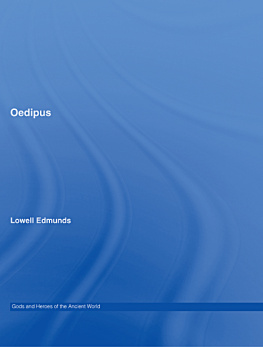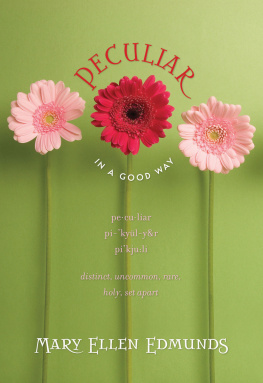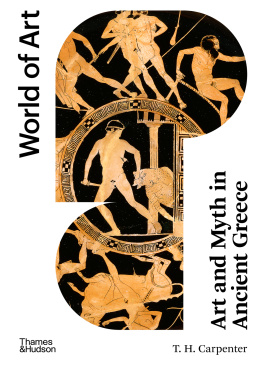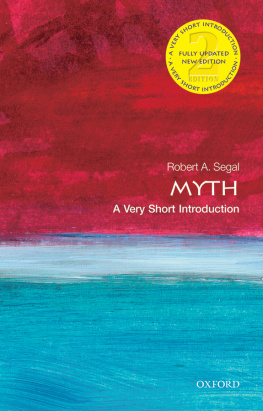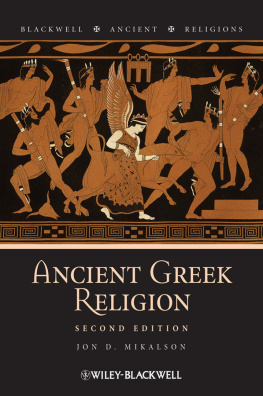Lowell Edmunds - Approaches to Greek Myth
Here you can read online Lowell Edmunds - Approaches to Greek Myth full text of the book (entire story) in english for free. Download pdf and epub, get meaning, cover and reviews about this ebook. year: 2014, publisher: Johns Hopkins University Press, genre: Romance novel. Description of the work, (preface) as well as reviews are available. Best literature library LitArk.com created for fans of good reading and offers a wide selection of genres:
Romance novel
Science fiction
Adventure
Detective
Science
History
Home and family
Prose
Art
Politics
Computer
Non-fiction
Religion
Business
Children
Humor
Choose a favorite category and find really read worthwhile books. Enjoy immersion in the world of imagination, feel the emotions of the characters or learn something new for yourself, make an fascinating discovery.

- Book:Approaches to Greek Myth
- Author:
- Publisher:Johns Hopkins University Press
- Genre:
- Year:2014
- Rating:4 / 5
- Favourites:Add to favourites
- Your mark:
- 80
- 1
- 2
- 3
- 4
- 5
Approaches to Greek Myth: summary, description and annotation
We offer to read an annotation, description, summary or preface (depends on what the author of the book "Approaches to Greek Myth" wrote himself). If you haven't found the necessary information about the book — write in the comments, we will try to find it.
Lowell Edmunds: author's other books
Who wrote Approaches to Greek Myth? Find out the surname, the name of the author of the book and a list of all author's works by series.
Approaches to Greek Myth — read online for free the complete book (whole text) full work
Below is the text of the book, divided by pages. System saving the place of the last page read, allows you to conveniently read the book "Approaches to Greek Myth" online for free, without having to search again every time where you left off. Put a bookmark, and you can go to the page where you finished reading at any time.
Font size:
Interval:
Bookmark:
Approaches to Greek Myth
Second Edition
Edited by Lowell Edmunds

1990, 2014 Johns Hopkins University Press
All rights reserved. Published 2014
Printed in the United States of America on acid-free paper
9 8 7 6 5 4 3 2 1
Johns Hopkins University Press
2715 North Charles Street
Baltimore, Maryland 21218-4363
www.press.jhu.edu
Library of Congress Cataloging-in-Publication Data
Approaches to Greek myth / edited by Lowell Edmunds. Second edition.
pages cm
Includes bibliographical references and index.
ISBN-13: 978-1-4214-1418-8 (hardcover : alk. paper)
ISBN-13: 978-1-4214-1419-5 (pbk. : alk. paper)
ISBN-13: 978-1-4214-1420-1 (electronic)
ISBN-10: 1-4214-1418-X (hardcover : alk. paper)
ISBN-10: 1-4214-1419-8 (pbk. : alk. paper)
ISBN-10: 1-4214-1420-1 (electronic)
1. Mythology, Greek. I. Edmunds, Lowell.
BL790.A66 2014
292.1'3dc23 2013043623
A catalog record for this book is available from the British Library.
Special discounts are available for bulk purchases of this book.
For more information, please contact Special Sales at 410-516-6936 or .
Johns Hopkins University Press uses environmentally friendly book materials, including recycled text paper that is composed of at least 30 percent post-consumer waste, whenever possible.
Lowell Edmunds
Jordi Pmias
H. S. Versnel
Carolina Lpez-Ruiz
Joseph Falaky Nagy
William Hansen
Claude Calame
Christiane Sourvinou-Inwood
Robert A. Segal
The quarter-century that has passed since the first edition of this book has witnessed an enormous interest in Greek mythin scholarship, the arts, and popular culture. For students and scholars, who are addressed here, excellent companions and handbooks have put on record the main ways of thinking about this always intriguing, always contested subject. These works, which I have cited again and again in my general introduction and in my separate introductions to each of the chapters, also offer bibliographical aids that this book does not aspire to reduplicate, let alone surpass.
This second edition complements the handbooks and companions, discussing at some length and in some detail eight approaches to Greek myth. Two chapters reprinted from the first edition (Versnels and Sourvinou-Inwoods) have been reedited and provided with new contextualizations in my introductions. Three chapters have been revised (those of Nagy, Hansen, and Calame, to whom I am grateful for their willingness to participate in this project). Two chapters, those on Greek and Near Eastern mythologies and on Greek myth and psychoanalysis, have new authors (Lpez-Ruiz and Segal), and a new chapter (by Pmias) gives a history of the reception of Greek myth. To these three new authors I am also grateful. All these chapters have new introductions. A chapter from the first edition has been dropped (the one on Greek myth and history, a topic considered at the end of my general introduction). The approaches discussed in these chapters will not soon cease to be of interest. These are, in the sequence in which they appear in this book, the history of myth, myth and ritual, comparative mythology (Near Eastern, Indo-European), comparative folklore, narratology, iconography, and psychoanalysis.
If the passage of time since the first edition has made possible the gains or hoped-for gains of all the revision, it has also brought a particular loss. Those who knew Christiane Sourvinou-Inwood, who died in 2007, remember her brilliant, sometimes impassioned conversation. The originality and force of her mind persist in her chapter reprinted here.
Email makes everything easier except the customary expression, at this point, of gratitude to all those who helped the author or, in this case, the editor. So many messages have gone and come that it is no longer possible for me to keep track of them. To mention some names might seem deliberately not to mention others. To all I offer warm thanks. Thanks also to Susan T. Edmunds for many useful conversations and for practical advice. Finally, I thank Linda Strange, whose lynx-eyed preparation of the manuscript for the printer improved every part, I could almost say every page, of this book.
Approaches to Greek Myth
LOWELL EDMUNDS
A Greek myth is a retold story about gods and heroes and sometimes the monsters with whom they have to contend. The setting of myths is in the past, and the past has a chronology that extends from the origin of the world and the gods down through the age of the heroes, with which the present time is continuous.
Anyone could retell a myth. In Euripides Ion, serving women, visitors at Delphi with their mistress, behold the sculpture on the west pediment of the temple of Apollo. Socrates presents a record of excellence that he thinks could inspire present-day citizens to emulate their ancestors, and this excellence is the meaning he gives, in the context, to Athenian history, including the early mythical part.
To know the myths and to be able to tell them was normal. This ability is still assumed in the period of the Roman domination of Greece, as by Strabo (1st c. B.C.E.), who somewhat disprizes it, in his Geography. Contrasting the value of his own work with history and myths (muthoi), he makes the point that myths have no practical application:
As Strabos way of introducing his example suggests (a man, which in Greek is , someone), the ability to tell such stories was not special.
About two centuries later, when the knowledge of Greek myths was beginning to fade, Greeks who wanted to know about this aspect of their heritage could turn to various kinds of support. The Bibliotheca (Library) of Apollodorus (probably 2nd c. C.E.), which is our standard handbook of Greek myth, is the best-known example. While it may have had more than one purpose and more than one intended readership in its own time, it certainly bears comparison in some respects to the mythical material found in the subliterary papyri. Monique van Rossum-Steenbeek, in a study of four categories of such papyri, calls them a kind of readers digest containing noteworthy knowledge. One category is the learned list of names, of which there are several in Apollodorus. We have no way of knowing whether Apollodorus expected that any of his readers would memorize his list of suitors, but we can at least say that his presentation of such a list is flattering. His readers might, he implies, wish to learn all these names, or some of them, and in this way to display their familiarity with their cultural heritage.
The womens reference to myth-telling in Ion was prompted by the sight of sculpture in a pediment. Visual contact with Greek myth was normal and, one can assume, a daily occurrence in antiquityindeed, the primary access to myth, along with story-telling, for most persons. of this book).
Verbal sources remain the predominant ones for most students of Greek myth. Oral myth-telling, impromptu, as by the women at Delphi, or in regularized contexts like the symposium, was normal but usually went unrecorded. Some would say (this view is discussed below) that poetic performance was the primary mode of the communication of myths.
In Greek poetry, myth shows two contrary tendencies that clearly predate our earliest sources. One is system and the other is variation.
Next pageFont size:
Interval:
Bookmark:
Similar books «Approaches to Greek Myth»
Look at similar books to Approaches to Greek Myth. We have selected literature similar in name and meaning in the hope of providing readers with more options to find new, interesting, not yet read works.
Discussion, reviews of the book Approaches to Greek Myth and just readers' own opinions. Leave your comments, write what you think about the work, its meaning or the main characters. Specify what exactly you liked and what you didn't like, and why you think so.

